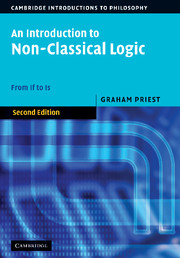Book contents
- Frontmatter
- Contents
- Preface to the First Edition
- Preface to the Second Edition
- Mathematical Prolegomenon
- Part I Propositional Logic
- 1 Classical Logic and the Material Conditional
- 2 Basic Modal Logic
- 3 Normal Modal Logics
- 4 Non-normal Modal Logics; Strict Conditionals
- 5 Conditional Logics
- 6 Intuitionist Logic
- 7 Many-valued Logics
- 8 First Degree Entailment
- 9 Logics with Gaps, Gluts and Worlds
- 10 Relevant Logics
- 11 Fuzzy Logics
- 11a Appendix: Many-valued Modal Logics
- Postscript: An Historical Perspective on Conditionals
- Part II Quantification and Identity
- Postscript: A Methodological Coda
- References
- Index of Names
- Index of Subjects
2 - Basic Modal Logic
Published online by Cambridge University Press: 05 June 2012
- Frontmatter
- Contents
- Preface to the First Edition
- Preface to the Second Edition
- Mathematical Prolegomenon
- Part I Propositional Logic
- 1 Classical Logic and the Material Conditional
- 2 Basic Modal Logic
- 3 Normal Modal Logics
- 4 Non-normal Modal Logics; Strict Conditionals
- 5 Conditional Logics
- 6 Intuitionist Logic
- 7 Many-valued Logics
- 8 First Degree Entailment
- 9 Logics with Gaps, Gluts and Worlds
- 10 Relevant Logics
- 11 Fuzzy Logics
- 11a Appendix: Many-valued Modal Logics
- Postscript: An Historical Perspective on Conditionals
- Part II Quantification and Identity
- Postscript: A Methodological Coda
- References
- Index of Names
- Index of Subjects
Summary
Introduction
2.1.1 In this chapter, we look at the basic technique – possible-world semantics – variations on which will occupy us for most of the following chapters. (We will return to the subject of the conditional in chapter 4.)
2.1.2 This will take us into an area called modal logic. This chapter concerns the most basic modal logic, K (after Kripke).
Necessity and Possibility
2.2.1 Modal logic concerns itself with the modes in which things may be true/false, particularly their possibility, necessity and impossibility. These notions are highly ambiguous, a subject to which we will return in the next chapter.
2.2.2 The modal semantics that we will examine employ the notion of a possible world. Exactly what possible worlds are, we will return to later in this chapter. For the present, the following will suffice. We can all imagine that things might have been different. For example, you can imagine that things are exactly the same, except that you are a centimetre taller. What you are imagining here is a different situation, or possible world. Of course, the actual world is a possible world too, and there are indefinitely many others as well, where you are two centimetres taller, three centimetres taller, where you have a different colour hair, where you were born in another country, and so on.
- Type
- Chapter
- Information
- An Introduction to Non-Classical LogicFrom If to Is, pp. 20 - 35Publisher: Cambridge University PressPrint publication year: 2008



